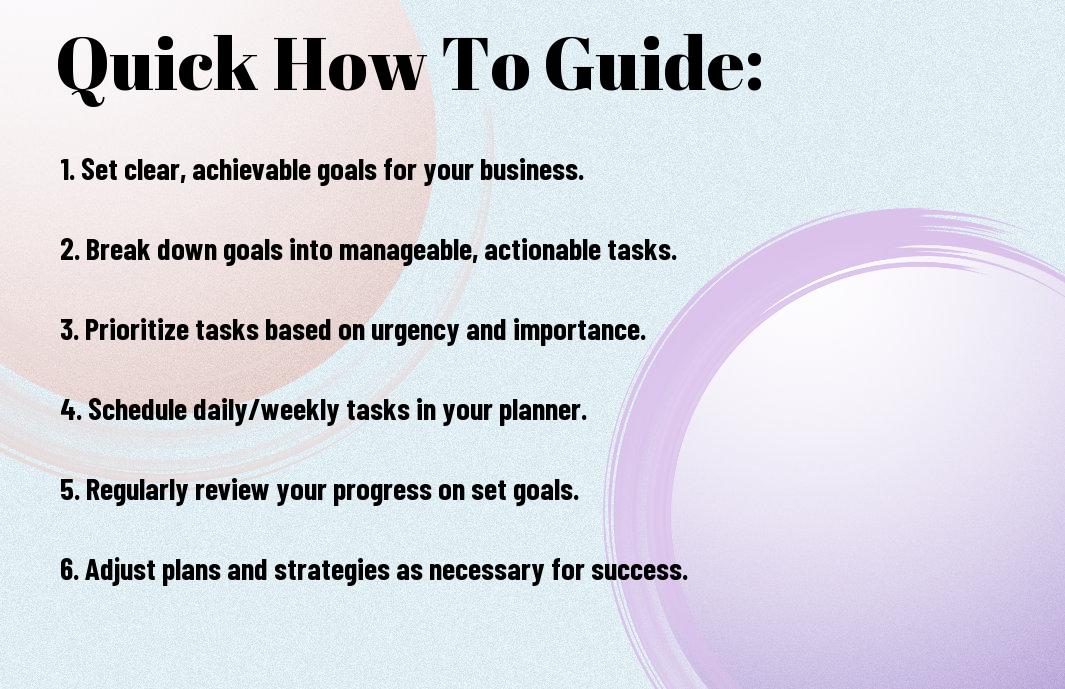I rely on a powerful tool to propel my small business toward success: the small business planner. By harnessing its features, I can effectively organize tasks, set achievable goals, and track my progress. In this post, I’ll share how you can utilize your own planner to create a roadmap for your business journey, keeping you on track even in challenging times. Let’s examine how to maximize this vital resource and transform your ambitions into accomplishments.
Key Takeaways:
- Define clear, specific goals to provide direction and focus in your planning process.
- Break down larger objectives into manageable tasks and set deadlines to maintain accountability.
- Regularly review your progress and adjust your strategies as needed to stay aligned with your goals.

Understanding the Importance of a Small Business Planner
Before stepping into the daily tasks of running my business, I realized how vital a small business planner was in keeping me focused and on target. A planner serves as my roadmap, allowing me to track progress, set priorities, and manage my time effectively. By using one, you can navigate the complexities of entrepreneurship with greater ease, ensuring that you stay aligned with your overarching goals and long-term vision.
Benefits of Planning for Small Businesses
There’s a multitude of advantages that come with implementing effective planning strategies. Firstly, it helps in clearly defining your objectives, which can enhance your productivity. Secondly, it allows you to allocate resources efficiently, avoiding unnecessary waste. Additionally, having a plan can boost your confidence, as you have a structured approach to achieving your goals.

Key Factors to Consider When Choosing a Planner
Factors to keep in mind when selecting a planner include:
- Format: Choose between physical or digital planners based on your preference.
- Features: Look for checklists, calendars, or goal-setting sections.
- Size: Consider portability versus workspace.
- Customization: Personalization options enhance usability.
- Cost: Ensure it fits within your budget.
Any planner you select should suit your unique business needs.
Plus, think about how a planner can adapt to your specific style. The right planner should not only match your organizational habits but also motivate you to stay on track. Evaluate options based on their flexibility and user-friendliness to ensure they align with your workflow. Here are additional factors to consider:
- Durability: A sturdy planner can withstand daily use.
- Design: An aesthetically pleasing planner can inspire you.
- Accessibility: Look for planners that integrate with your digital tools.
Any details that enhance your planning experience are worth considering.

How to Effectively Use Your Small Business Planner
Any effective use of your small business planner begins with routine engagement. Make it a habit to review your planner daily or weekly, ensuring you are consistently tracking your goals and adjusting tasks as necessary. Utilizing color coding or different sections for specific areas of your business can also streamline this process, helping you stay organized and focused on what truly matters.
Setting Clear Goals and Objectives
An necessary part of using a small business planner is setting clear goals and objectives. I break down larger goals into manageable steps, ensuring that each objective is specific, measurable, attainable, relevant, and time-bound. This clarity enables me to maintain focus and assess progress consistently.
Prioritizing Tasks and Time Management
Business owners often juggle numerous responsibilities, so effectively prioritizing tasks is vital for success. I utilize my planner to categorize tasks based on urgency and importance, allowing for a more strategic approach to my daily activities. This ensures I focus on high-impact tasks first, maximizing my productivity.
Clear prioritization and time management can significantly enhance your efficiency. I often list out my daily tasks and indicate their importance and deadline. By addressing high-priority items first, I can minimize overwhelm and maintain momentum in my workflow. Additionally, I always leave some buffer time for unexpected challenges, which is necessary in the world of small business, where flexibility can lead to positive outcomes.
Tips for Staying on Track with Your Planner
Many small business owners struggle with maintaining focus on their goals, but using a planner can significantly enhance your productivity. Here are some tips to help you stay on track:
- Set clear goals and priorities
- Schedule regular check-ins to assess progress
- Break larger tasks into manageable steps
- Stay consistent with your planning routine
Knowing how to effectively utilize your planner will lead you to achieve your business goals more efficiently.
Regular Review and Reflection
Regularly reviewing your progress is imperative for staying aligned with your objectives. I suggest setting aside time weekly or monthly to reflect on achievements, reassess priorities, and make necessary adjustments. This practice allows you to maintain focus and adapt your strategies, ensuring that you remain on the path to success.
Incorporating Flexibility in Your Planning
For effective planning, incorporating flexibility is key. I find that allowing room for unexpected changes in your schedule can improve both productivity and peace of mind. When plans shift or challenges arise, it’s important not to feel overwhelmed.
For instance, unexpected interruptions can disrupt your timeline, but if you allow for flexibility within your planner, you can easily adjust without feeling stressed. I recommend having a buffer in your schedule or creating a “catch-up” day to help you stay on track. This approach not only helps you manage your tasks effectively but also reduces the feeling of overwhelm that can occur when facing unforeseen hurdles. Embracing flexibility ensures that you can adapt while still aiming for your goals.
Common Mistakes to Avoid When Using a Planner
Despite my best intentions, I’ve found that several common mistakes can derail my planning efforts. You may find it helpful to explore the Top 10 Tips on How to Use a Small Business Planner to enhance your effectiveness.
Underestimating Time for Tasks
An important lesson I’ve learned is to allocate sufficient time for each task. It’s easy to think that a project will take only an hour, but I’ve often discovered that unexpected challenges arise, leading to a rush to meet deadlines.
Neglecting to Update Your Planner
One of the biggest errors I’ve made is neglecting to keep my planner updated. As my projects evolve, it’s important that I consistently record changes; doing so helps me stay aligned with my goals.
Mistakes in this area can lead to a disorganized approach. If I fail to note adjustments, I risk missing important deadlines and creating confusion in my workflow. Keeping my planner updated enables me to track progress accurately and maintain motivation towards my objectives. The act of regularly reviewing and modifying my planner builds a positive momentum that drives my productivity forward.
Tools and Resources to Enhance Your Planning
Once again, leveraging the right tools and resources can significantly improve your planning process. By incorporating various planning tools into your strategy, you can streamline your efforts, stay organized, and ultimately achieve your business objectives more effectively. From planners and notebooks to digital tools and resources, there are numerous options available to help you navigate your planning journey.
Digital vs. Paper Planners
While some people swear by the tactile experience of a paper planner, others prefer the convenience and efficiency of digital planners. Each option has its unique advantages, allowing you to choose what best fits your personal style and workflow. Consider your tendencies: do you enjoy the act of writing by hand, or do you seek easy access and organization through technology?
Recommended Apps and Software
Enhance your planning experience by exploring various apps and software designed specifically for small business owners. These digital tools can offer functionalities like goal tracking, project management, and collaboration features to help you maintain focus and efficiency.
Digital tools like Trello, Asana, and Notion can transform your planning process by providing intuitive interfaces and functionalities tailored to business needs. With features such as tasks management, deadline reminders, and collaboration opportunities, these platforms can help you stay organized and accountable. The ability to share and communicate within these apps facilitates teamwork and keeps your goals transparent. By embracing these resources, your planning experience can become more dynamic, empowering you to execute your vision effectively.
Developing a Routine for Consistent Planning
Now that you’ve acknowledged the importance of using a small business planner, developing a routine for consistent planning can significantly enhance your productivity. By incorporating planning into your daily or weekly schedule, you’ll cultivate a habit that ensures you stay focused on your goals. This consistency not only keeps you organized but also reinforces your commitment to your business journey.
Scheduling Regular Planning Sessions
An effective way to maintain momentum is by scheduling regular planning sessions. Allocate specific times each week dedicated to reviewing your progress and adjusting your strategies. By treating these sessions as appointments you cannot miss, you create a sense of priority around your planning process that fosters accountability.
Creating Accountability Measures
Routine is key to ensuring that you stick to your planning schedule. By sharing your goals with a peer, mentor, or even your employees, you create a supportive environment that encourages you to follow through. When others are aware of your plans and deadlines, you are more likely to stay committed.
Plus, having accountability measures in place amplifies your motivation. By involving someone else in your planning journey, you create a dynamic where external expectations empower you to take action. Whether it’s regular check-ins or sharing progress updates, these strategies transform your aspirations into tangible results. The inclusion of shared goals not only enhances your commitment but also creates a community that supports your entrepreneurial vision.
Conclusion
The effective use of a small business planner can significantly enhance my ability to stay organized and achieve my goals. By setting clear objectives, breaking tasks into manageable steps, and regularly reviewing my progress, I can keep myself accountable. Utilizing tools like a goal tracker template provides me with a structured way to monitor my journey and make adjustments as needed. With dedication and the right planner, I can navigate toward my business aspirations with clarity and confidence.
FAQ
Q: What are the key components of a small business planner that can help me stay organized?
A: A small business planner typically includes sections for goal setting, project timelines, financial planning, and daily/weekly schedules. Utilize the goal-setting section to outline both short-term and long-term objectives. The project timelines can help you track milestones and deadlines, ensuring tasks are completed on time. Financial planning pages are important for budgeting, tracking expenses, and assessing cash flow. Daily and weekly schedules allow you to prioritize tasks, helping maintain focus and productivity throughout your workweek.
Q: How can I effectively set and track my business goals using a planner?
A: To set and track business goals effectively, start by defining SMART goals (Specific, Measurable, Achievable, Relevant, Time-bound). Write these goals in your planner to have a clear reference. Break down each goal into smaller, actionable steps with deadlines and track your progress regularly. Use checklists, progress bars, or milestone markers to visually represent your advancement toward each goal. Scheduling regular reviews in your planner can help you evaluate your achievements, adjust your strategies, and stay aligned with your overall business vision.
Q: What tips can enhance my daily planning routine to improve productivity?
A: Enhance your daily planning routine by first prioritizing tasks based on urgency and importance. Start each day by reviewing your planner and identifying key tasks that must be completed. Consider using techniques like time blocking, where you allocate specific time slots for different activities, minimizing distractions. Incorporate regular breaks to recharge, making your workflow more sustainable. Lastly, at the end of the day, reflect on what was accomplished and adjust the next day’s plan based on pending tasks and new priorities. This iterative approach will make your planning more effective over time.







